Eco 101 Microeconomics: Analyzing Demand and Supply Elasticity
VerifiedAdded on 2023/05/31
|8
|1485
|157
Homework Assignment
AI Summary
This assignment delves into the core microeconomic concepts of price elasticity of demand and supply, differentiating between elastic and inelastic demand. It explains how consumers alter their quantities demanded in response to price changes, highlighting the differences between the slope of the demand curve and the elasticity of demand. The assignment also discusses substitute goods and their impact on demand elasticity, illustrating how the availability of substitutes affects consumer responsiveness to price changes. Furthermore, it examines how total revenue changes with price variations under elastic and inelastic demand conditions, and how the slope and elasticity of demand differ along a negatively sloped straight-line demand curve. The document uses figures and examples to clarify key concepts and references relevant academic sources.
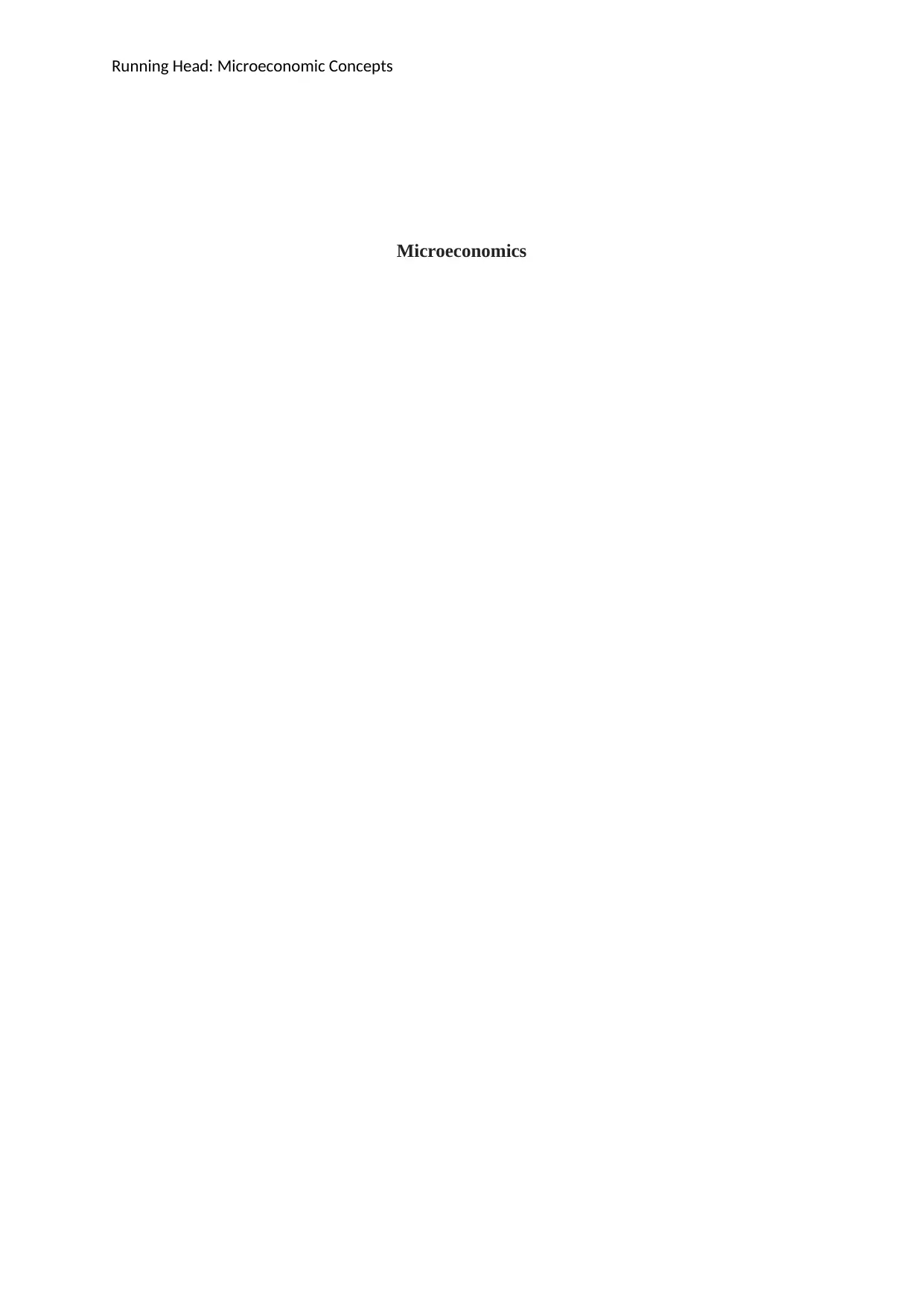
Running Head: Microeconomic Concepts
Microeconomics
Microeconomics
Paraphrase This Document
Need a fresh take? Get an instant paraphrase of this document with our AI Paraphraser
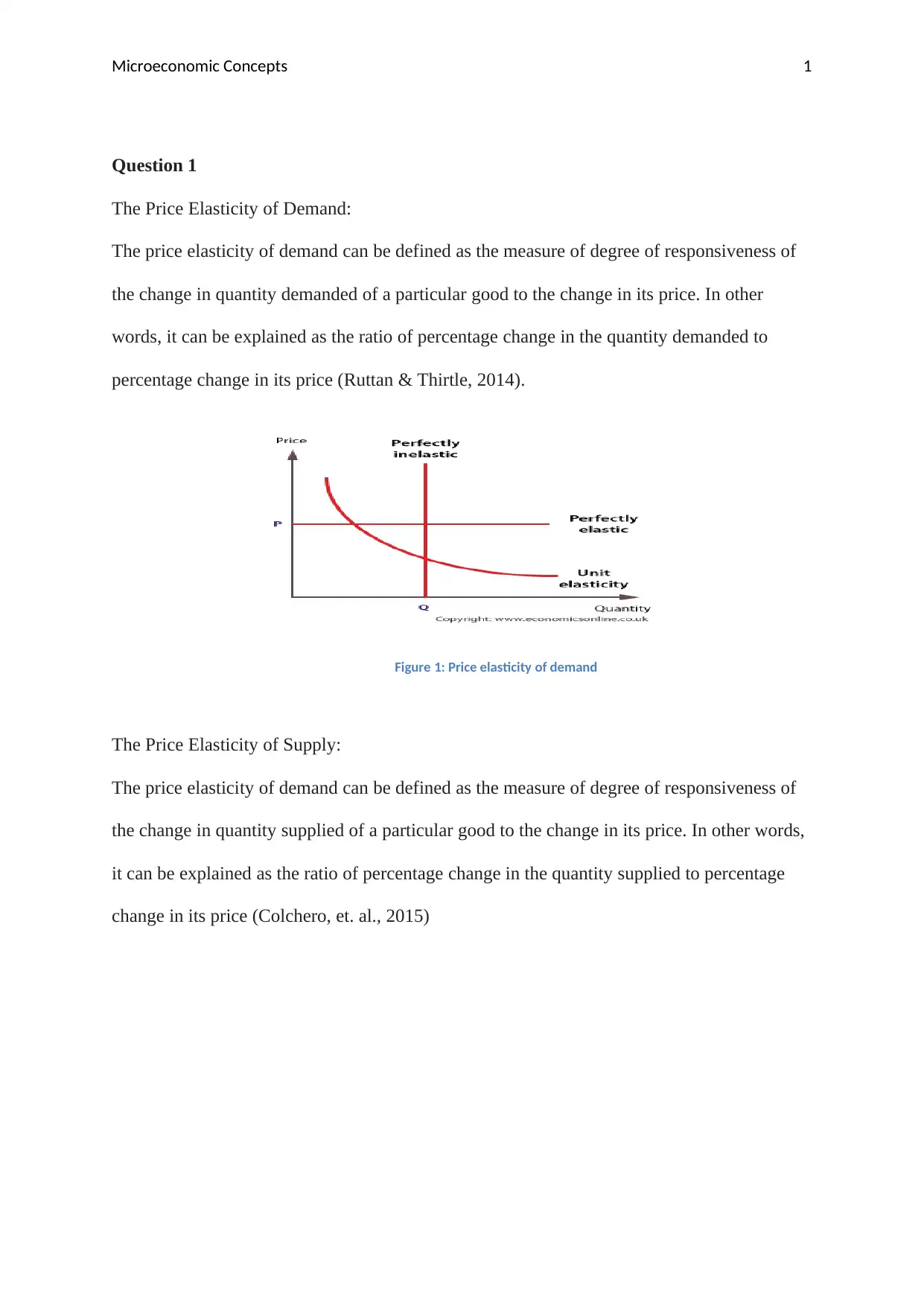
Microeconomic Concepts 1
Question 1
The Price Elasticity of Demand:
The price elasticity of demand can be defined as the measure of degree of responsiveness of
the change in quantity demanded of a particular good to the change in its price. In other
words, it can be explained as the ratio of percentage change in the quantity demanded to
percentage change in its price (Ruttan & Thirtle, 2014).
Figure 1: Price elasticity of demand
The Price Elasticity of Supply:
The price elasticity of demand can be defined as the measure of degree of responsiveness of
the change in quantity supplied of a particular good to the change in its price. In other words,
it can be explained as the ratio of percentage change in the quantity supplied to percentage
change in its price (Colchero, et. al., 2015)
Question 1
The Price Elasticity of Demand:
The price elasticity of demand can be defined as the measure of degree of responsiveness of
the change in quantity demanded of a particular good to the change in its price. In other
words, it can be explained as the ratio of percentage change in the quantity demanded to
percentage change in its price (Ruttan & Thirtle, 2014).
Figure 1: Price elasticity of demand
The Price Elasticity of Supply:
The price elasticity of demand can be defined as the measure of degree of responsiveness of
the change in quantity supplied of a particular good to the change in its price. In other words,
it can be explained as the ratio of percentage change in the quantity supplied to percentage
change in its price (Colchero, et. al., 2015)
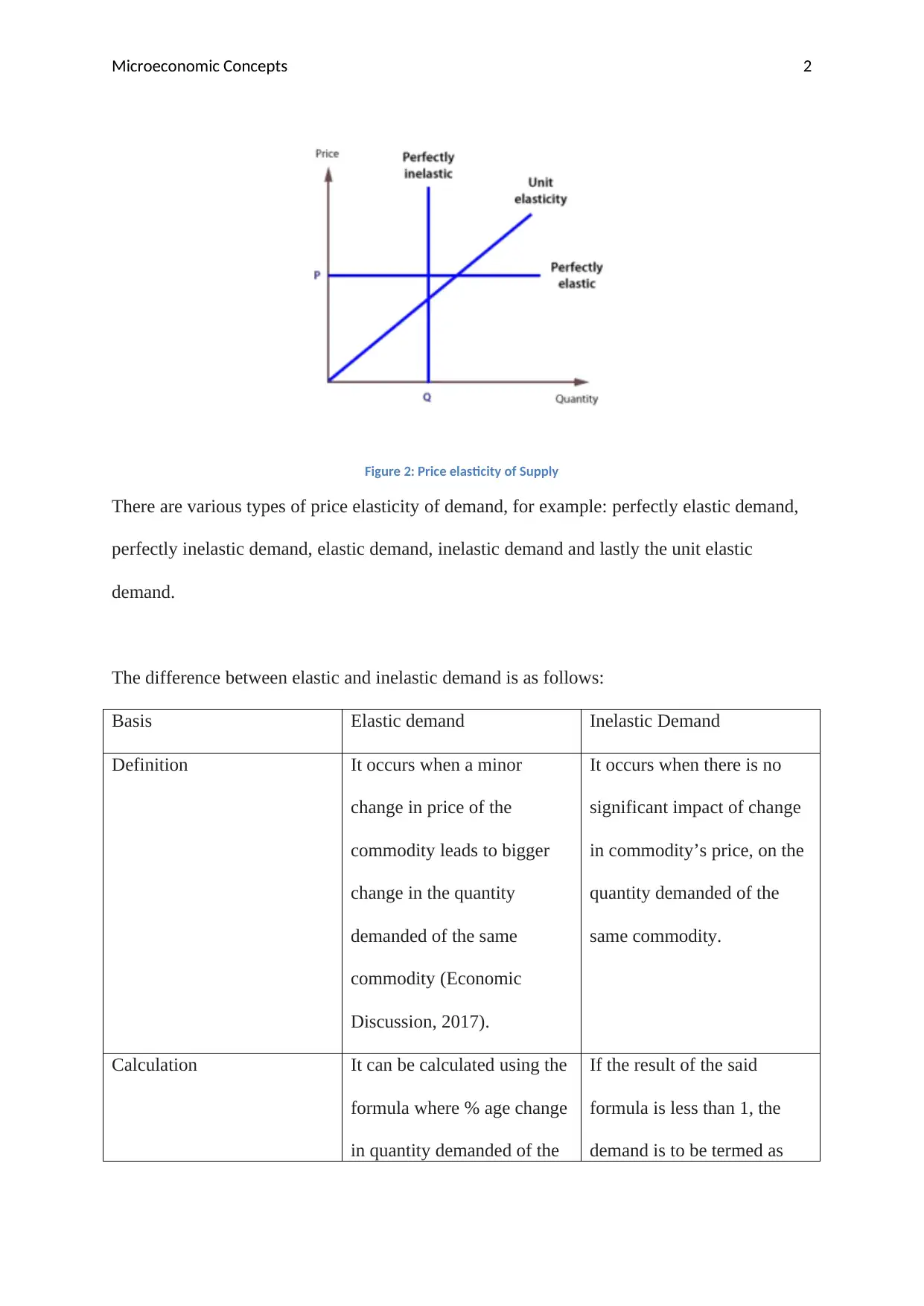
Microeconomic Concepts 2
Figure 2: Price elasticity of Supply
There are various types of price elasticity of demand, for example: perfectly elastic demand,
perfectly inelastic demand, elastic demand, inelastic demand and lastly the unit elastic
demand.
The difference between elastic and inelastic demand is as follows:
Basis Elastic demand Inelastic Demand
Definition It occurs when a minor
change in price of the
commodity leads to bigger
change in the quantity
demanded of the same
commodity (Economic
Discussion, 2017).
It occurs when there is no
significant impact of change
in commodity’s price, on the
quantity demanded of the
same commodity.
Calculation It can be calculated using the
formula where % age change
in quantity demanded of the
If the result of the said
formula is less than 1, the
demand is to be termed as
Figure 2: Price elasticity of Supply
There are various types of price elasticity of demand, for example: perfectly elastic demand,
perfectly inelastic demand, elastic demand, inelastic demand and lastly the unit elastic
demand.
The difference between elastic and inelastic demand is as follows:
Basis Elastic demand Inelastic Demand
Definition It occurs when a minor
change in price of the
commodity leads to bigger
change in the quantity
demanded of the same
commodity (Economic
Discussion, 2017).
It occurs when there is no
significant impact of change
in commodity’s price, on the
quantity demanded of the
same commodity.
Calculation It can be calculated using the
formula where % age change
in quantity demanded of the
If the result of the said
formula is less than 1, the
demand is to be termed as
⊘ This is a preview!⊘
Do you want full access?
Subscribe today to unlock all pages.

Trusted by 1+ million students worldwide

Microeconomic Concepts 3
good is kept in numerator
and % age change in price of
the good is kept in
denominator.
If the result is greater than or
equal to 1.
inelastic.
Curve The curve has a shallow
shape in case of elastic
demand.
The slope is steep in case of
inelastic demand.
Direction The movement of price and
revenue is in opposite
direction in the situation
when demand is elastic.
When the demand is
inelastic, the price as well as
revenue moves in similar
direction.
Examples Comforts and luxuries Items of necessity
Question 2:
It is a correct fact that both demand curve and demand elasticity are the true measures of
consumer’s responsiveness towards the changes in the level of the prices. The consumers
promptly changes the level of quantity demanded with the change in the price of such
product. Though the concept of slope of demand curve and elasticity of demand are related to
each other but still they are not the same thing (Hastings & Tejeda-Ashton, 2008). The
elasticity of demand cannot be determined by referring to the slope of demand function even
though it is generally believed that the steeper the demand curve, the lower is the elasticity of
the demand of the product. However, this concept is not absolutely correct. It is quite possible
good is kept in numerator
and % age change in price of
the good is kept in
denominator.
If the result is greater than or
equal to 1.
inelastic.
Curve The curve has a shallow
shape in case of elastic
demand.
The slope is steep in case of
inelastic demand.
Direction The movement of price and
revenue is in opposite
direction in the situation
when demand is elastic.
When the demand is
inelastic, the price as well as
revenue moves in similar
direction.
Examples Comforts and luxuries Items of necessity
Question 2:
It is a correct fact that both demand curve and demand elasticity are the true measures of
consumer’s responsiveness towards the changes in the level of the prices. The consumers
promptly changes the level of quantity demanded with the change in the price of such
product. Though the concept of slope of demand curve and elasticity of demand are related to
each other but still they are not the same thing (Hastings & Tejeda-Ashton, 2008). The
elasticity of demand cannot be determined by referring to the slope of demand function even
though it is generally believed that the steeper the demand curve, the lower is the elasticity of
the demand of the product. However, this concept is not absolutely correct. It is quite possible
Paraphrase This Document
Need a fresh take? Get an instant paraphrase of this document with our AI Paraphraser
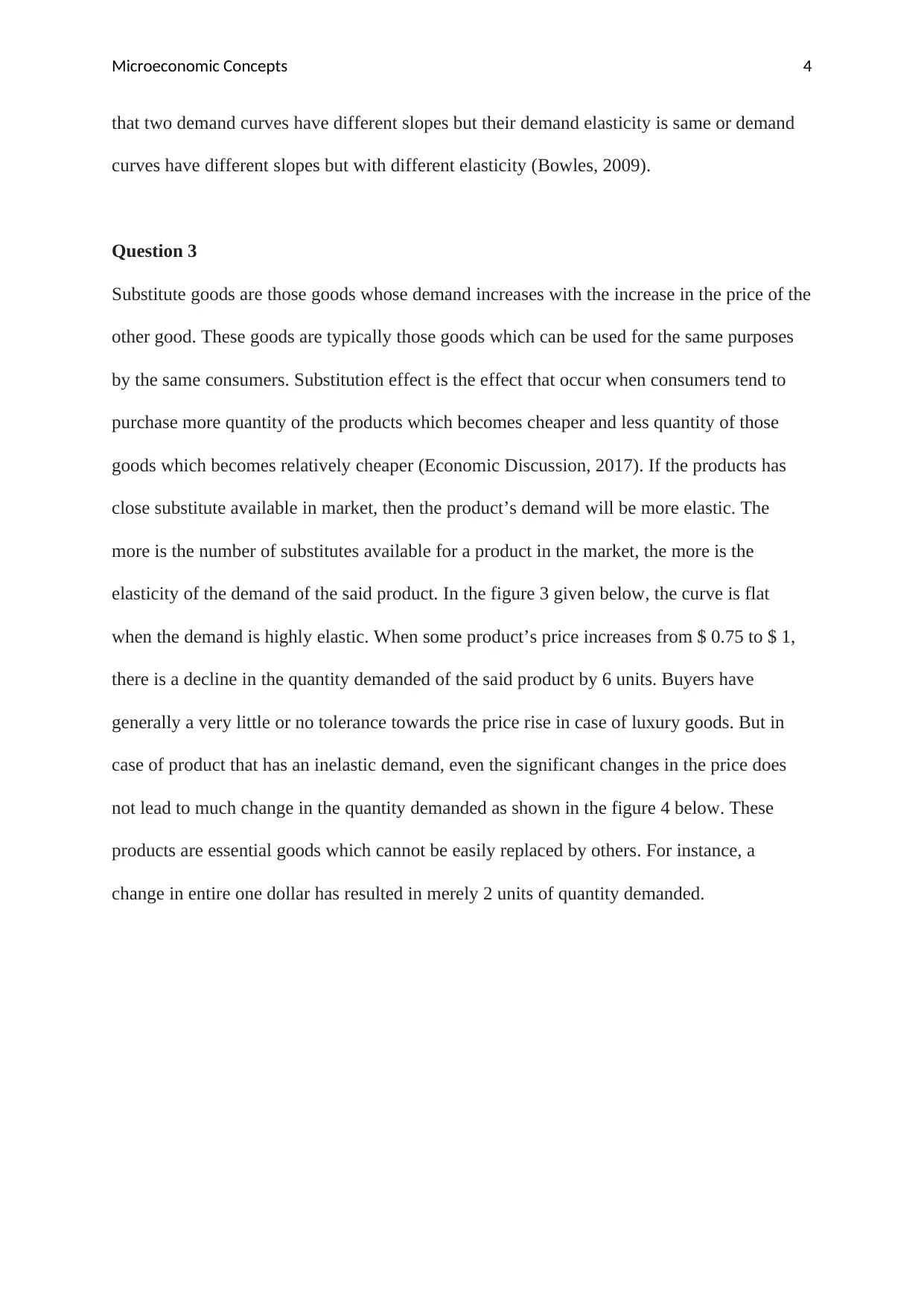
Microeconomic Concepts 4
that two demand curves have different slopes but their demand elasticity is same or demand
curves have different slopes but with different elasticity (Bowles, 2009).
Question 3
Substitute goods are those goods whose demand increases with the increase in the price of the
other good. These goods are typically those goods which can be used for the same purposes
by the same consumers. Substitution effect is the effect that occur when consumers tend to
purchase more quantity of the products which becomes cheaper and less quantity of those
goods which becomes relatively cheaper (Economic Discussion, 2017). If the products has
close substitute available in market, then the product’s demand will be more elastic. The
more is the number of substitutes available for a product in the market, the more is the
elasticity of the demand of the said product. In the figure 3 given below, the curve is flat
when the demand is highly elastic. When some product’s price increases from $ 0.75 to $ 1,
there is a decline in the quantity demanded of the said product by 6 units. Buyers have
generally a very little or no tolerance towards the price rise in case of luxury goods. But in
case of product that has an inelastic demand, even the significant changes in the price does
not lead to much change in the quantity demanded as shown in the figure 4 below. These
products are essential goods which cannot be easily replaced by others. For instance, a
change in entire one dollar has resulted in merely 2 units of quantity demanded.
that two demand curves have different slopes but their demand elasticity is same or demand
curves have different slopes but with different elasticity (Bowles, 2009).
Question 3
Substitute goods are those goods whose demand increases with the increase in the price of the
other good. These goods are typically those goods which can be used for the same purposes
by the same consumers. Substitution effect is the effect that occur when consumers tend to
purchase more quantity of the products which becomes cheaper and less quantity of those
goods which becomes relatively cheaper (Economic Discussion, 2017). If the products has
close substitute available in market, then the product’s demand will be more elastic. The
more is the number of substitutes available for a product in the market, the more is the
elasticity of the demand of the said product. In the figure 3 given below, the curve is flat
when the demand is highly elastic. When some product’s price increases from $ 0.75 to $ 1,
there is a decline in the quantity demanded of the said product by 6 units. Buyers have
generally a very little or no tolerance towards the price rise in case of luxury goods. But in
case of product that has an inelastic demand, even the significant changes in the price does
not lead to much change in the quantity demanded as shown in the figure 4 below. These
products are essential goods which cannot be easily replaced by others. For instance, a
change in entire one dollar has resulted in merely 2 units of quantity demanded.
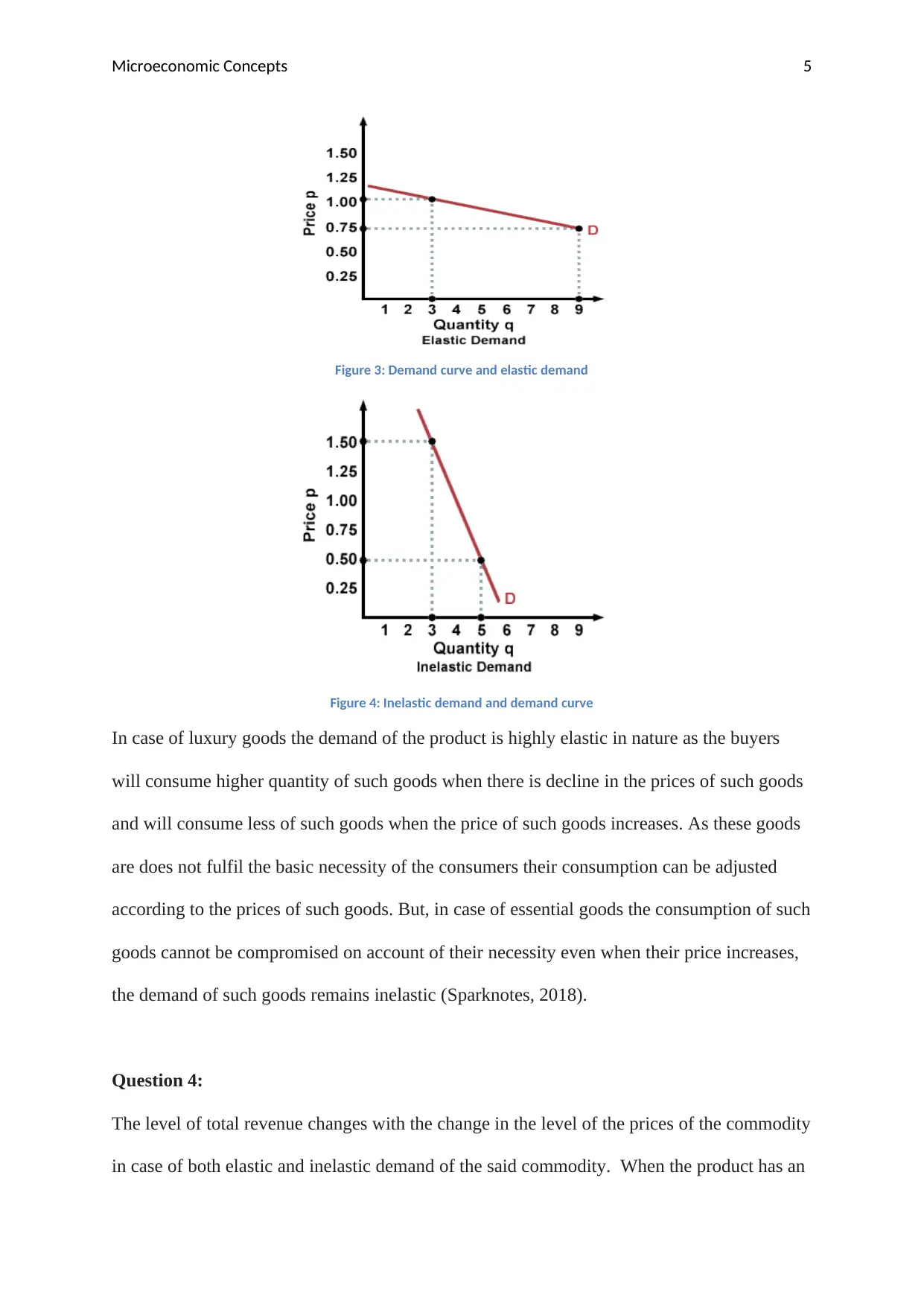
Microeconomic Concepts 5
Figure 3: Demand curve and elastic demand
Figure 4: Inelastic demand and demand curve
In case of luxury goods the demand of the product is highly elastic in nature as the buyers
will consume higher quantity of such goods when there is decline in the prices of such goods
and will consume less of such goods when the price of such goods increases. As these goods
are does not fulfil the basic necessity of the consumers their consumption can be adjusted
according to the prices of such goods. But, in case of essential goods the consumption of such
goods cannot be compromised on account of their necessity even when their price increases,
the demand of such goods remains inelastic (Sparknotes, 2018).
Question 4:
The level of total revenue changes with the change in the level of the prices of the commodity
in case of both elastic and inelastic demand of the said commodity. When the product has an
Figure 3: Demand curve and elastic demand
Figure 4: Inelastic demand and demand curve
In case of luxury goods the demand of the product is highly elastic in nature as the buyers
will consume higher quantity of such goods when there is decline in the prices of such goods
and will consume less of such goods when the price of such goods increases. As these goods
are does not fulfil the basic necessity of the consumers their consumption can be adjusted
according to the prices of such goods. But, in case of essential goods the consumption of such
goods cannot be compromised on account of their necessity even when their price increases,
the demand of such goods remains inelastic (Sparknotes, 2018).
Question 4:
The level of total revenue changes with the change in the level of the prices of the commodity
in case of both elastic and inelastic demand of the said commodity. When the product has an
⊘ This is a preview!⊘
Do you want full access?
Subscribe today to unlock all pages.

Trusted by 1+ million students worldwide
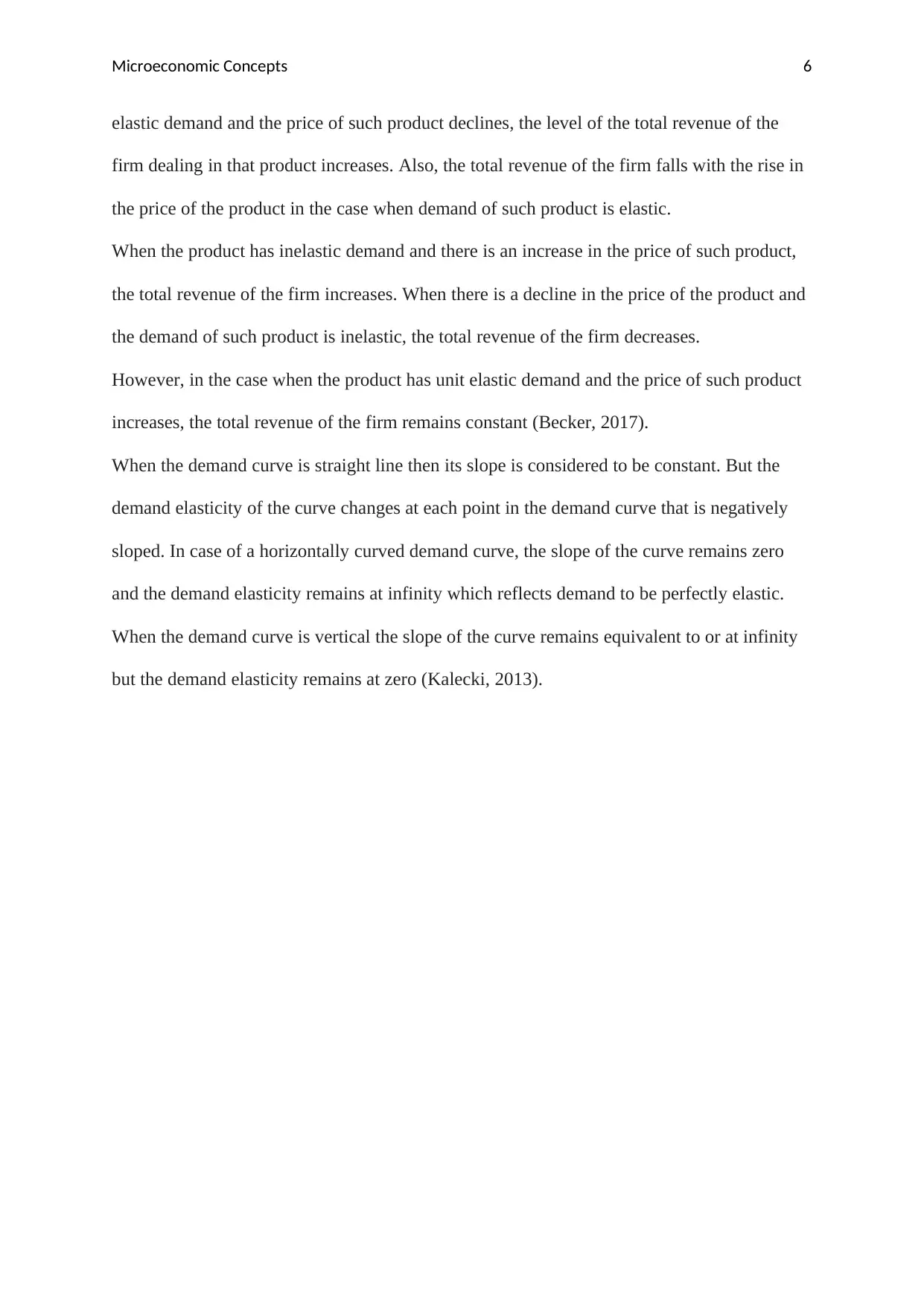
Microeconomic Concepts 6
elastic demand and the price of such product declines, the level of the total revenue of the
firm dealing in that product increases. Also, the total revenue of the firm falls with the rise in
the price of the product in the case when demand of such product is elastic.
When the product has inelastic demand and there is an increase in the price of such product,
the total revenue of the firm increases. When there is a decline in the price of the product and
the demand of such product is inelastic, the total revenue of the firm decreases.
However, in the case when the product has unit elastic demand and the price of such product
increases, the total revenue of the firm remains constant (Becker, 2017).
When the demand curve is straight line then its slope is considered to be constant. But the
demand elasticity of the curve changes at each point in the demand curve that is negatively
sloped. In case of a horizontally curved demand curve, the slope of the curve remains zero
and the demand elasticity remains at infinity which reflects demand to be perfectly elastic.
When the demand curve is vertical the slope of the curve remains equivalent to or at infinity
but the demand elasticity remains at zero (Kalecki, 2013).
elastic demand and the price of such product declines, the level of the total revenue of the
firm dealing in that product increases. Also, the total revenue of the firm falls with the rise in
the price of the product in the case when demand of such product is elastic.
When the product has inelastic demand and there is an increase in the price of such product,
the total revenue of the firm increases. When there is a decline in the price of the product and
the demand of such product is inelastic, the total revenue of the firm decreases.
However, in the case when the product has unit elastic demand and the price of such product
increases, the total revenue of the firm remains constant (Becker, 2017).
When the demand curve is straight line then its slope is considered to be constant. But the
demand elasticity of the curve changes at each point in the demand curve that is negatively
sloped. In case of a horizontally curved demand curve, the slope of the curve remains zero
and the demand elasticity remains at infinity which reflects demand to be perfectly elastic.
When the demand curve is vertical the slope of the curve remains equivalent to or at infinity
but the demand elasticity remains at zero (Kalecki, 2013).
Paraphrase This Document
Need a fresh take? Get an instant paraphrase of this document with our AI Paraphraser

Microeconomic Concepts 7
References:
Becker, G.S., 2017. Economic theory. Routledge.
Bowles, S., 2009. Microeconomics: behavior, institutions, and evolution. Princeton
University Press.
Colchero, M.A., Salgado, J.C., Unar-Munguia, M., Hernandez-Avila, M. and Rivera-
Dommarco, J.A., 2015. Price elasticity of the demand for sugar sweetened beverages and soft
drinks in Mexico. Economics & Human Biology, 19, pp.129-137.
Economic Discussion, 2017. Factors Affecting the Price Elasticity of Demand | Economics.
Available at: http://www.economicsdiscussion.net/elasticity-of-demand/factors-affecting-the-
price-elasticity-of-demand-economics/22226 Accessed on 28.11.2018
Economic Discussion, 2017. Slope of Demand Function and Elasticity of Demand:
Differences. Available at: http://www.economicsdiscussion.net/elasticity-of-demand/slope-
of-demand-function-and-elasticity-of-demand-differences/16783 Accessed on 28.11.2018
Hastings, J.S. and Tejeda-Ashton, L., 2008. Financial literacy, information, and demand
elasticity: Survey and experimental evidence from Mexico (No. w14538). National Bureau of
Economic Research.
Kalecki, M., 2013. Theory of economic dynamics. Routledge.
Ruttan, V. and Thirtle, C., 2014. The role of demand and supply in the generation and
diffusion of technical change. Routledge.
Sparknotes, 2018. Elasticity Topics. Available at:
https://www.sparknotes.com/economics/micro/elasticity/section1/ Accessed on 28.11.2018
References:
Becker, G.S., 2017. Economic theory. Routledge.
Bowles, S., 2009. Microeconomics: behavior, institutions, and evolution. Princeton
University Press.
Colchero, M.A., Salgado, J.C., Unar-Munguia, M., Hernandez-Avila, M. and Rivera-
Dommarco, J.A., 2015. Price elasticity of the demand for sugar sweetened beverages and soft
drinks in Mexico. Economics & Human Biology, 19, pp.129-137.
Economic Discussion, 2017. Factors Affecting the Price Elasticity of Demand | Economics.
Available at: http://www.economicsdiscussion.net/elasticity-of-demand/factors-affecting-the-
price-elasticity-of-demand-economics/22226 Accessed on 28.11.2018
Economic Discussion, 2017. Slope of Demand Function and Elasticity of Demand:
Differences. Available at: http://www.economicsdiscussion.net/elasticity-of-demand/slope-
of-demand-function-and-elasticity-of-demand-differences/16783 Accessed on 28.11.2018
Hastings, J.S. and Tejeda-Ashton, L., 2008. Financial literacy, information, and demand
elasticity: Survey and experimental evidence from Mexico (No. w14538). National Bureau of
Economic Research.
Kalecki, M., 2013. Theory of economic dynamics. Routledge.
Ruttan, V. and Thirtle, C., 2014. The role of demand and supply in the generation and
diffusion of technical change. Routledge.
Sparknotes, 2018. Elasticity Topics. Available at:
https://www.sparknotes.com/economics/micro/elasticity/section1/ Accessed on 28.11.2018
1 out of 8
Related Documents
Your All-in-One AI-Powered Toolkit for Academic Success.
+13062052269
info@desklib.com
Available 24*7 on WhatsApp / Email
![[object Object]](/_next/static/media/star-bottom.7253800d.svg)
Unlock your academic potential
Copyright © 2020–2025 A2Z Services. All Rights Reserved. Developed and managed by ZUCOL.




